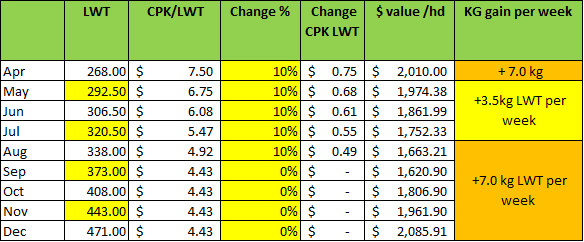In January of this year, we reported that the price of 250 to 300kg Autumn drop steers at the Western Victorian weaner sales traded in the 530 to 570¢/Kg Liveweight (lwt) range. At the time, it was calculated as 33% higher than the previous high price posted in 2017. The calves dropped in the spring of 2020 are now at weaning stage and on the back of an excellent season are now weighing in at 240 to 275kg lwt. With plenty of grass, the decision to sell or hold through to normal sale times is not an easy one.
The value per kilogram is at levels for these types of cattle never before seen, with the demand from restockers and feedlots moving to secure supply the key drivers of these prices.
The question for breeders, however, is should they “take the money and run”, or given the beef outlook and with feed in the paddocks do they stick to the normal program and with another spring on these calves sell them at 400kg plus weights?
Each breeder will have a slightly different situation, but in general, the expected calf weight gains, based on the pasture ahead of these weaners, is at “best ever” levels.
To include a high-level overview of the market, a summary of the situation shows that while we have record cattle prices, the shortage of stock and the post-drought feed situation suggests that the market is unlikely to crash.
It is also accepted that prices at these levels are unlikely to continue upwards setting new price records either. The question is will the weight gain (with grass considered a “cheap” commodity this year), be enough to compensate for any price reduction either as a result of heavier weight cattle slotting into lower price brackets, or a general market correction?
To do the sums a wide range of assumptions are required. We have started with a 268kg lwt steer at $7.50/kg lwt, or $2,010 per head value. This is probably the easy part.
To run the model, we have assumed 7.0kg per week weight gain for April, reducing to an average of 3.5 kg through the winter, then ramping up through the spring and early summer back to 7.0 kg per week.
We have also taken the view that the price will decline progressively as the steers gain weight, with an orderly reduction of 10% per month to September, finally sitting at $4.43/kg lwt as the steers approach 400kg lwt.
While this is a theoretical model, it provides a view of the weight of the steers over the journey, alongside their estimated value.
What does it mean?
Every situation will be different depending on current weight and weight gain, however the model used identifies that it will not be until the calves reach 400 Kg plus late this year that their value will match the current price available for them now.
It’s always an incentive for breeders to make the most of grass in the paddock, but this presents a compelling argument to at least sell some of the current calf drop (perhaps 50% is the number), and although well below their normal turnoff weights, their $ per head return is better than any previous calf prices.
Have any questions or comments?
Key Points
- Demand pushes light weaner calf prices to extreme levels.
- Assumptions include the good season and an expected reducing cents per kilogram price
- Taking some “money off the table” makes sense
Click on figure to expand
Click on figure to expand
Data sources: MLA, Mecardo



